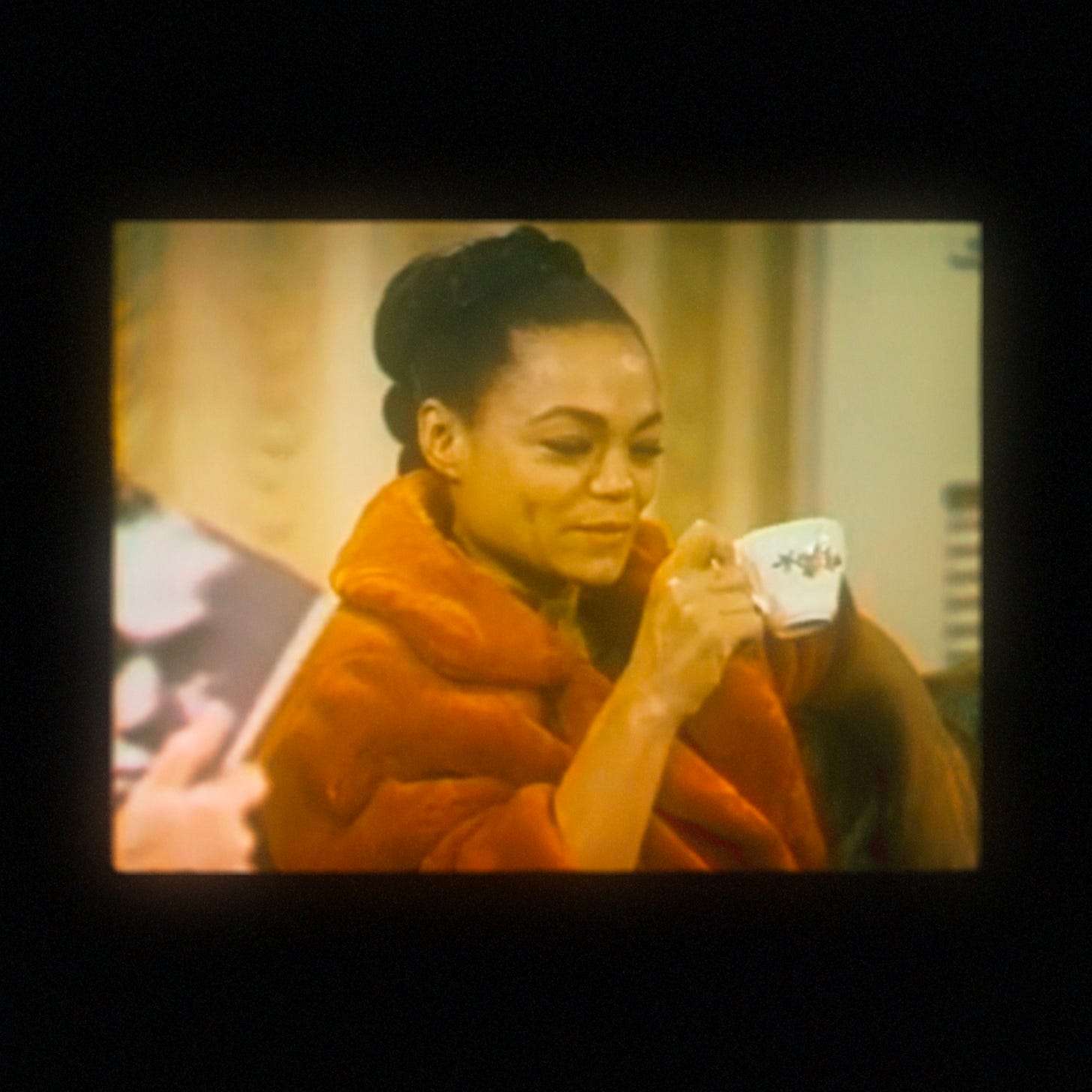Letter 9: Eartha Kitt on Uncompromising Self-Worth
4 Embodiment Practices to Reclaim Self-Love and Decenter Romantic Validation
A man comes into my life and I have to compromise?
For what?
For what?
— Eartha Kitt
Long before we had language for decentering men, for boundaries, for embodiment or self-worth, Eartha Kitt was already living it.
She practiced self-love in the way she lived her life, in the choices she made and in the things she refused to give up.
She lived alone.
She raised her daughter on her own terms.
She didn’t shrink herself to be palatable.
She didn’t contort her truth into something softer.
She didn’t see compromise as a prerequisite for intimacy.
And she never confused being loved with being worthy.
In a culture that taught women to center men, to soften their voices, delay their dreams and make room for someone else first, Eartha chose to do something else: She chose herself.
And in doing so, she modeled a kind of radical self-worth that still makes people uncomfortable. That’s how ahead of her time she was.
Let us look at 4 Ways Eartha embodied and incorporated this throughout her life…
1. She wasn’t Chosen, so She Chose Herself
Born into poverty in South Carolina, rejected by her mother’s partner for being mixed-race, Eartha Kitt was passed from home to home. She grew up knowing what it meant to feel unchosen and othered. And instead of spending her life trying to earn love, she built a life rooted in self-respect.
Her pain didn’t make her bitter but it gave her an inner confidence that didn’t need validation. She decided early: if no one else would claim her, she would learn to belong to herself.
Self-Worth through Embodiment Movement
At fifteen, she ran away to New York City, chasing a future that no one promised her. She danced in the streets until someone noticed her. She then joined the Katherine Dunham Company, where movement wasn’t just performance but it was healing, reclamation and embodiment. She learned how to use her voice, her body, her presence and to take up space with her hips, her shoulders, her breath. She reclaimed her sensuality, her power, her skin. She didn’t wait to be told she was beautiful. She moved like she already knew. Her self-worth lived in her bones, in her walk, in the way she took up space.
Try This: Embody Self-Choice
Stand tall. Breathe deep.
Walk slowly across the room like you belong to yourself.Let each step say: I choose me.
2. On Not Compromising Herself, Ever
I fall in love with myself, and I want someone to share it with me.
— Eartha Kitt
Eartha Kitt didn’t fear solitude, in fact she was so comfortable by herself that the idea of giving that up for the sake of a man seemed almost laughable.
In the 1982 documentary All By Myself: The Eartha Kitt Story, Eartha sits in her garden at a table, leaning forward and laughing with all of her face and body, in the most unapologetic way, when asked if she would ever compromise for a man. “Compromise? For what?” she exclaims, her entire being erupting with delight at the absurdity of the question. It is the laughter of someone who knows exactly who she is:
Her laugh said it all: the question was absurd.
Eartha prioritised joy, autonomy and pleasure on her own terms, and she did this decades before it was safe or celebrated for women, especially Black women, to do so. Her life wasn’t designed to make others comfortable. It was designed to be fully, fiercely her own.
Eartha had romantic relationships, including a marriage to businessman John William McDonald, with whom she had her only daughter. But the marriage ended after four years. Eartha later said she felt more like a possession than a partner. She was too independent, too expressive, too much for men who expected her to shrink. After that, she never remarried.
Instead, she chose to live on her own, raising her daughter as a single mother, traveling the world, and devoting herself to her work and well-being. Love, for her, had to match the life she’d built, not ask her to abandon it.
She once said, “I fall in love with myself, and I want someone to share it with me.” That was the order: self-love first, companionship second. She reminds us that independence doesn’t mean isolation. It means knowing how to nourish your own spirit before offering it to someone else.
Try This: De-center Romantic Validation
Place one hand on your heart, one on your belly. Breathe deeply.
Say: Anyone who enters my life is an addition, not the center.Move slowly, roll your shoulders, sway your hips.
Ask: What makes my life feel rich without anyone else in it?Let your body say: I am already whole.
3. She Reclaimed Sensuality on Her Own Terms
Men never wanted to love me. They wanted to lay me down, but not pick me up.
— Eartha Kitt
Eartha Kitt was desired by many but deeply loved by few. She once said, “Men never wanted to love me. They wanted to lay me down, but not pick me up.” The difference between being wanted and being truly held was very clear to her.
She was rarely met with tenderness that she expected. So she took back the narrative. Her sensuality was never a performance for male approval. It was an energy she cultivated for herself. The way she moved, dressed, spoke, danced made every gesture intentional and embodied.
She also did not dull her magnetism to be taken seriously, nor did she apologize for being too much. She didn’t play coy to make herself more acceptable. Her presence was a form of resistance by being playful, provocative and in control.
Eartha reminds us that owning your sensuality is not the same as offering it up. You can be magnetic and radiate power without asking for permission. You can be the flame and not the fuel.
Try This: Reclaim Your Sensuality
Put on a song that makes you feel alive.
Move just for you, not to be seen, but to feel.Let your body say: I am mine.
4. Living with Intention and Creating the Space for It
That sultry, purring voice Eartha Kitt is known for was not her natural voice. As a child, she mimicked birds and street sounds, shaping her voice into something unforgettable. That is how she built her voice.
She created the rest of her life with the same attention around her own needs that she knew so well. Whether onstage or at home, Eartha lived deliberately, choosing what nourished her, what reflected her, what felt true.
Later in life, Eartha moved to a restored 18th-century barn on 80 acres in Merryall, Connecticut, where she lived with her daughter. She gardened, cooked, raised animals and built a life that was entirely her own.
Every corner of the home reflected her: herbs hanging to dry, firewood stacked for winter, meals made with care, music playing in the kitchen. She created herself a place where she could think, create and belong to herself fully.
Her home, like her life, was designed to fit: It reflected a strong woman, an artist, comfortable in her own skin, who faced the world straight on, in full possession of herself, the years she had lived, and the beauty she had grown around her.
Try This: Create Space with Intention
Choose one small corner of your home and make it yours.
Clear it. Add only what reflects you.Let it say: This life is mine to shape.
4 Eartha-Inspired Embodiment Practices for Returning to Yourself
Embody Self-Choice:
Walk slowly across the room like you belong to yourself.
Let each step say: I choose me.De-center Romantic Validation:
Let anyone who enters your life be an addition, not the center.
Let your body say: I am already whole.Reclaim Your Sensuality:
Put on a song that makes you feel alive.
Move not to be seen, but to feel.
Let your body say: I am mine.Create Space with Intention:
Choose one corner of your home and make it yours.
Let it say: This life is mine to shape.
Journal Prompt
Where in your life have you mistaken compromise for connection?
Where have you made yourself smaller to be loved, to be understood, to be chosen?
Where are you still shrinking or stretching to be loved?
What if you are already enough, as you are, right now?
You don’t need to shrink to be held.
You don’t need to grow to be worthy.
Write from the part of you that knows this.
Be as honest as you’ve never let yourself be.
This is just for you.
If this letter resonated, please like and share this essay.
Thank you for reading.
Much Love
— Earth Poet
Earth Poet is a weekly newsletter that unpacks quotes from cultural icons — writers, artists, provocateurs — and reflects on what they mean now, with creative rituals to explore and journal prompts for deep reflection — all woven into weekly essays on cultural and social themes.
Free readers receive biweekly essays and digests. Paid subscribers unlock weekly essays, the Monthly Dead Poet Advice column — where voices from the past answer questions from the present — and so much more.
References / Bibliography
Fig. 1 - Eartha Kitt, 1967, from here.
All By Myself: The Eartha Kitt Story (1982). Directed by Christian Blackwood. [Documentary film featuring Eartha Kitt’s iconic interview on compromise.]
Kitt, Eartha. I'm Still Here: Confessions of a Sex Kitten. Simon & Schuster, 1989.
Eartha Kitt interview clips, especially the “Compromise? For what?” segment, widely circulated via YouTube and social media from the 1982 documentary.
Biographical details sourced from public interviews, archived recordings, and verified profiles including the Smithsonian National Portrait Gallery and PBS's American Masters.
Selected quotes and paraphrased statements attributed to Eartha Kitt from verified interviews and her autobiography.









so beautiful ❤️